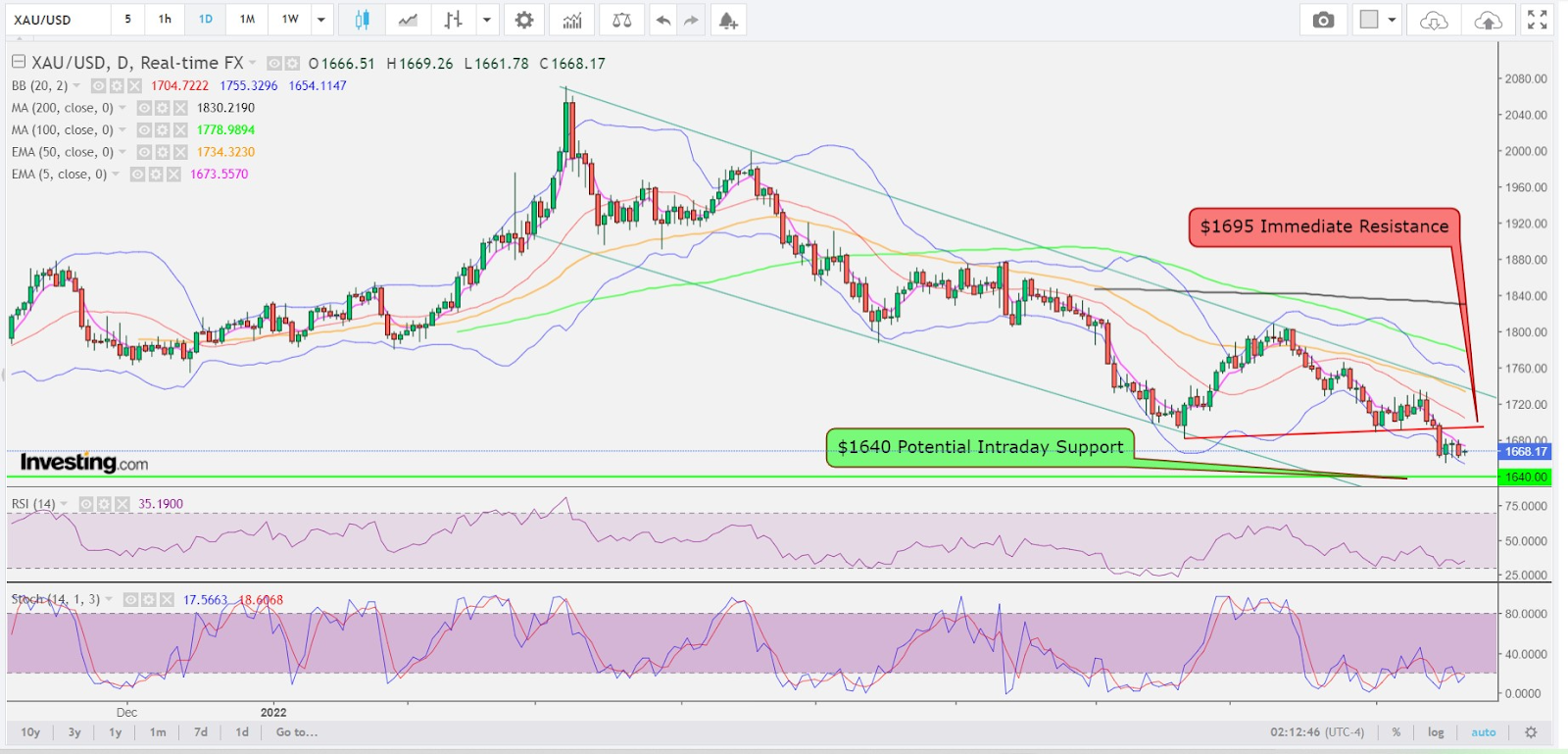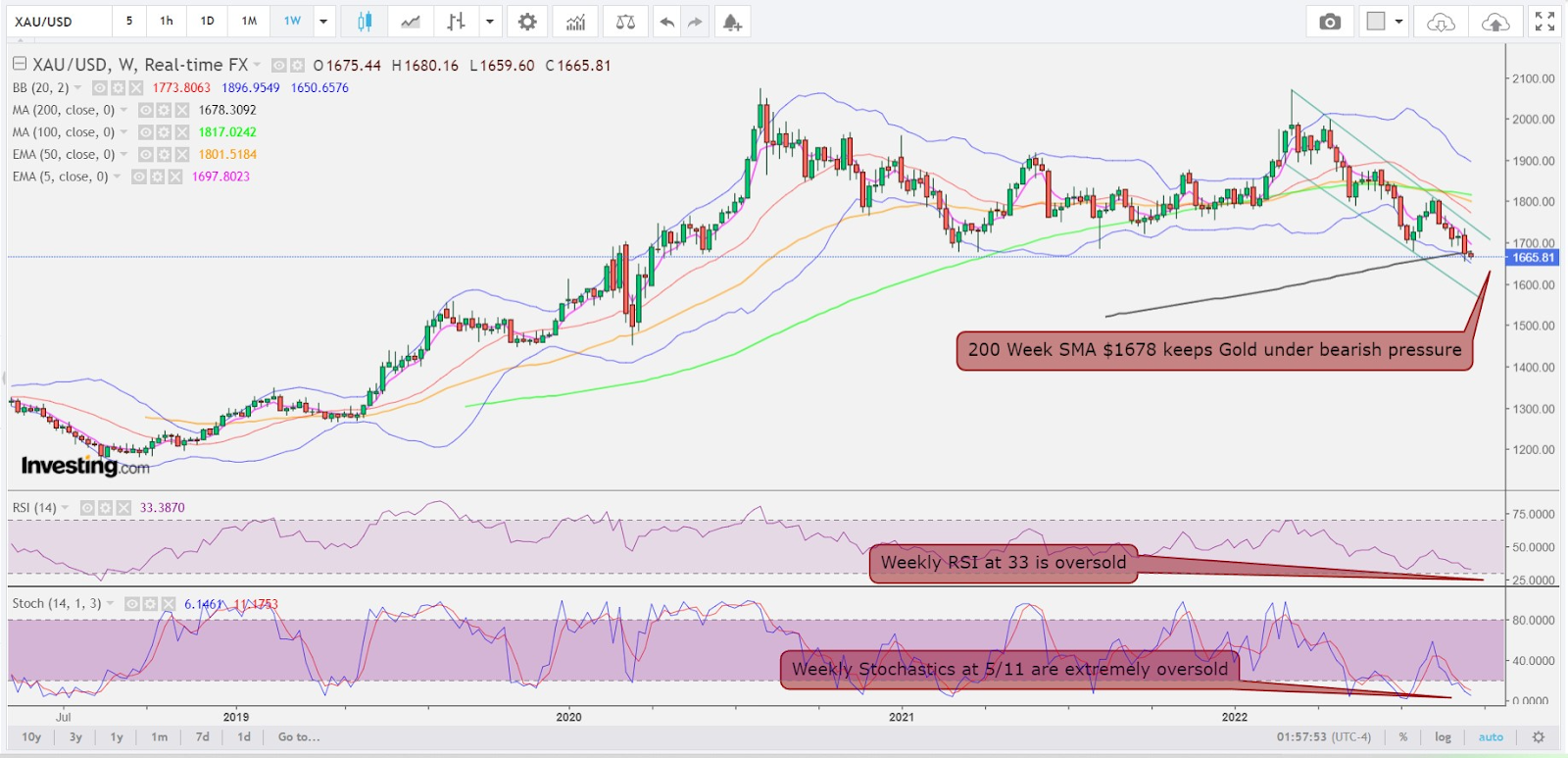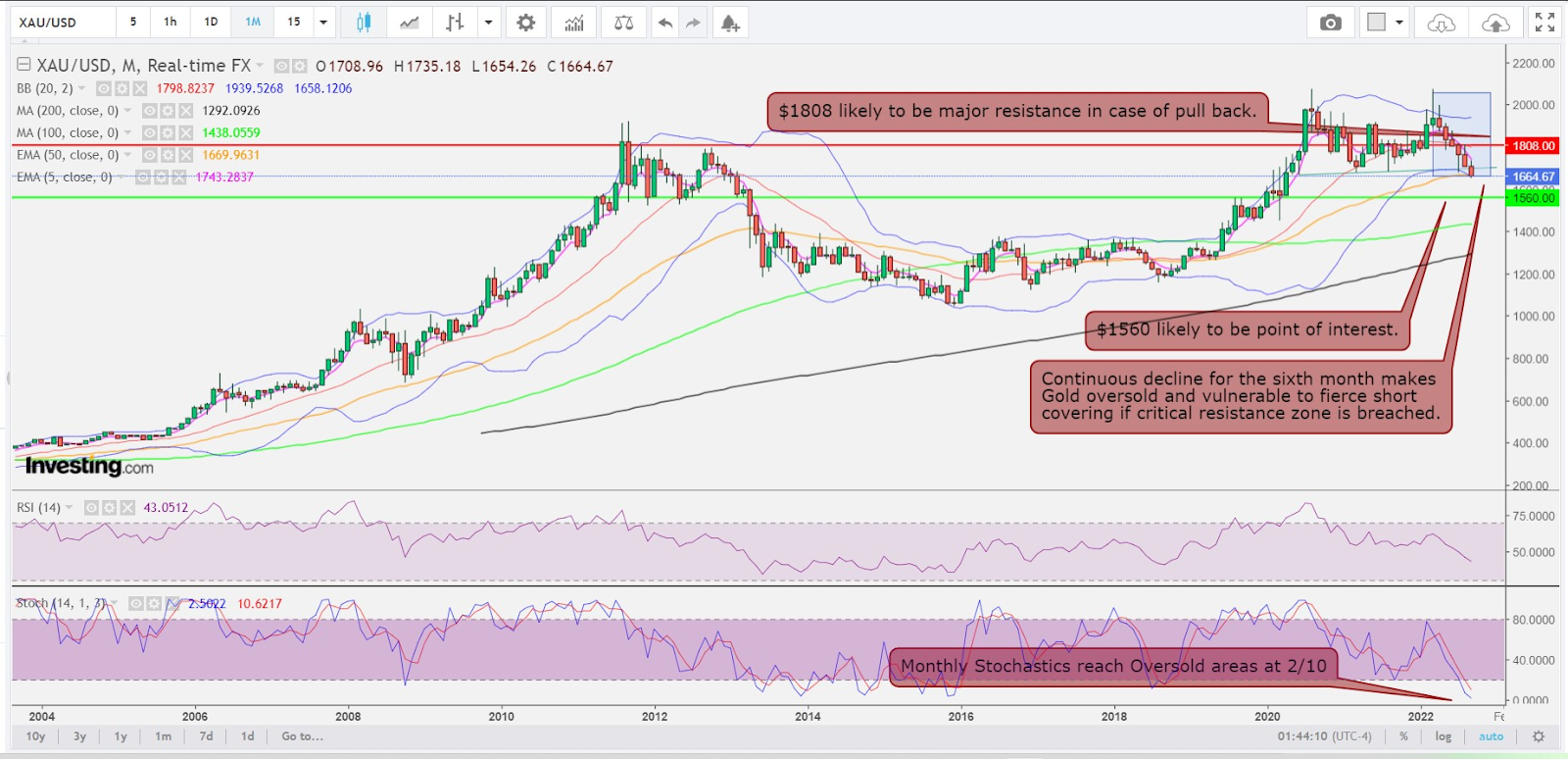- Oversold conditions make gold vulnerable to fierce short-covering
- Supportive buying from lows can start recovery towards $1,680-$1,685 and more
- Breaching the long-held $1,681 floor of support, the next leg lower is $1,560
- Dollar Index's resurgence to above 110 makes gold's short-term outlook bearish
Back in June, when we ran a preview like this on the day the US Federal Reserve imposed its first 75 basis point (bp) rate hike in 28 years, we got a pretty varied outcome in futures of gold.
The yellow metal's prices fell just briefly on the Fed decision, before surging higher over the next 24 hours to compensate for what appeared to be an oversold condition. Then, in a way that could only happen with gold, they tumbled almost non-stop over the next 12 days, losing about $100 or nearly 5.5%.
Today, we are on the cusp of what could be the third 75 bp hike in a row, in just over three months from that June decision. Then, gold hovered at around $1,750 an ounce, having lost its $1,800 perch after that Fed decision. Now, after some back-and-forth, the spot price of bullion is almost another $100 lower, hitting a 2½-year low of just beneath $1,660 on Monday.

Charts by SKCharting.com with data powered by Investing.com
Many believe things could get worse for gold before it gets better. The main reason for that would be the Fed's determination to not give up its super-hawkish stance on rates until it brings runaway inflation in the United States under control. The central bank’s performance in battling inflation, however, is far from convincing. The Fed's report card is like that of a student the teacher is hopeful will make it someday though isn’t entirely sure about.
Even after the Fed's 75 bp hike in June, inflation, as measured by the Consumer Price Index (CPI), peaked at an annualized of 9.1% that month, marking a new four-decade high (the CPI data is typically lagged by a month, to be sure). Price pressures have come down since, with the CPI slowing to an annualized 8.5% in July and 8.3% in August. But its retreat of 0.8% over two months versus two rate hikes totaling 1.5%—is dismal, to say the least.
Of course, the Fed could keep adding 75 bp increments to its remaining rate decisions for November and December to round out the year with rates ranging at 4.50-4.75%, compared to the zero to 0.25% it began 2022 with. Yet, it's anyone's guess where the CPI could be at that point. An educated guess would put it below 8% for sure, though there is still a good chance it would not be lower than 7.5%.

The Fed's long-declared goal for inflation is 2%. No one is sure how long it would take for the central bank to get there and if it will even be possible by 2024.
Fed Chair Jerome Powell has, however, said it was imperative that prices be reduced for low-income Americans, and, by that, he means monetary policy must be raised to "a somewhat restrictive level."
Rate hikes aside, the central bank's policy-making Federal Open Market Committee (FOMC) would be accelerating balance sheet reductions from September, cutting tens of billions of dollars it has been spending each month on bond buying to support the once pandemic-ravaged economy.
"Gold's 'September Swoon' could get uglier if the inflation fighting Fed decides not to blink at the risk of sending the economy into a recession," said Ed Moya, analyst at online trading platform OANDA.
"Fed Chair Powell's messaging will likely determine if gold gets crushed here. Gold will be in trouble if Powell is able to convince markets that not only will they remain aggressive with tightening, but that they will hold rates even as the economic downturn worsens. Gold volatility will remain elevated post FOMC as prices will likely have a strong case for either a move towards $1,600 or above the $1,700 level."

While some of that is looking out in the days, weeks, and months ahead, of immediate concern also is what could happen right after the FOMC rate decision at 14:00 ET (18:00 GMT) today.
Gold lost almost 4% in the seven sessions to Tuesday to remain moored in mid-$1,600 territory. During that stretch, the spot price also hit a 2½-year low beneath $1,654 on Friday.
Much of that happens to gold will, of course, be determined by the performance of the dollar, which is gearing again in the direction of the 20-year highs seen during most of August. If the dollar retreats again after today's rate hike—with bond yields on the US 10-year Treasury in tow—gold could catch a break hereon.
The following are the bull and bear scenarios for gold, that could come right after the Fed decision or imminently, as outlined by SKCharting.com's chief technical strategist Sunil Kumar Dixit:
Bull Scenario
Oversold conditions make gold vulnerable to fierce short covering if critical resistance zones are breached.
There are a few support points sitting as a coalition of $1650-$1640-$1620 en route.
Supportive buying from the lows can start recovery towards the immediate resistance zone of $1,680-$1,685, which helps gold test the next resistance zone of $1,695-$1,705.
A sustained break above this zone puts the 50-Day Exponential Moving Average of $1,726 and the previous week's high of $1735 as a challenge.
A weekly close above the 200-week Simple Moving Average of $1,678 will be an initial sign of rebound to be confirmed by a follow up close above $1,735.
A more convincing structure requires a break below $1,654 followed by a rebound and weekly close above $1,678. Further weekly close above $1,735 would add to the bullish charge towards the broken support-turned-resistance zone of $1765-$1808.
Bear Scenario
Since the time gold bears succeeded in breaching the long-held $1,681 floor of hard support, which corresponds to the 38.2% Fibonacci retracement of the $1,046 to $2,073 upwave, the next leg lower is a 50% Fibonacci retracement at $1,560.
Continuously falling for the sixth consecutive month, gold has limited room for a further correction towards the next major downside of $1,560, before the short-term support of $1,640 and $1,620 come into play.
As the Dollar Index resumes its bullish rebound above 110.20, gold's short-term trend outlook remains under bearish pressure. Though some intraday recovery towards $1,675 may be seen, clusters of resistance are positioned at $1683 and the intraday resistance of $1,695.
Disclaimer: Barani Krishnan uses a range of views outside his own to bring diversity to his analysis of any market. For neutrality, he sometimes presents contrarian views and market variables. He does not hold positions in the commodities and securities he writes about.
